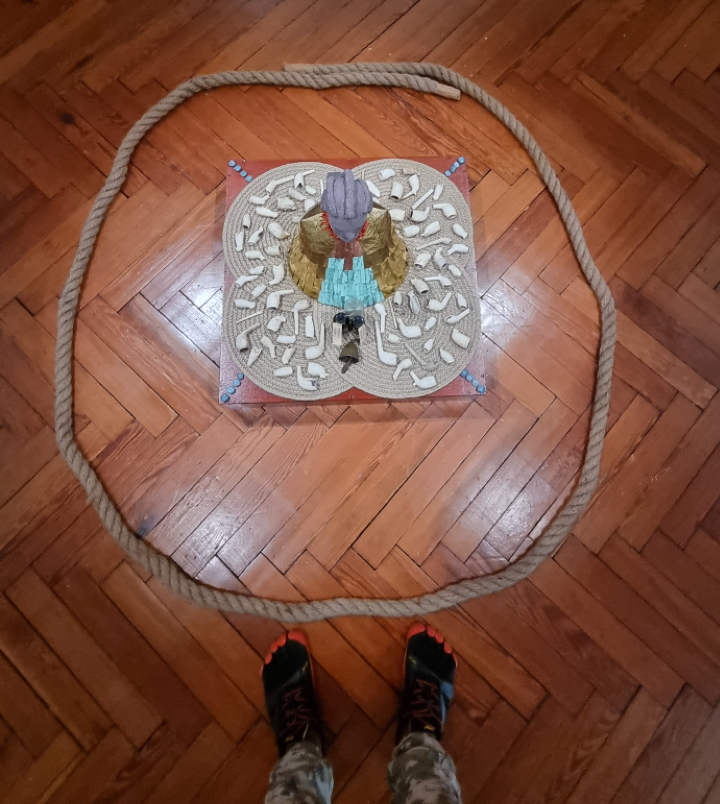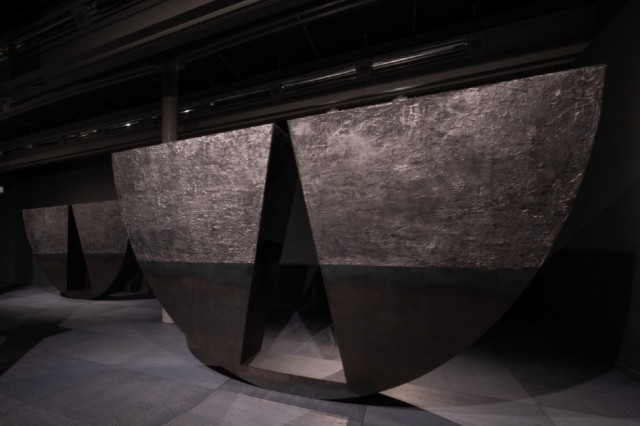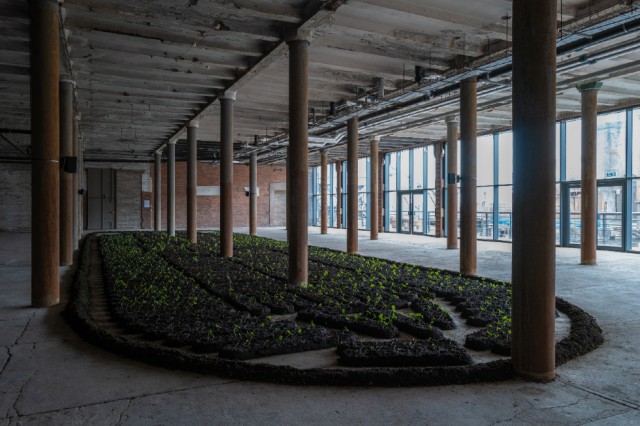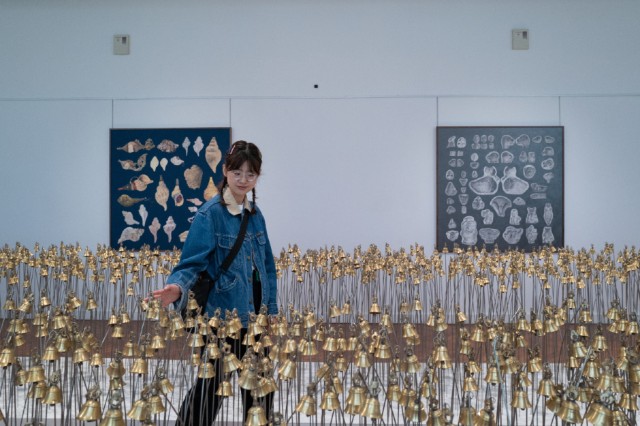Barefoot
Biennial as Spiritual Odyssey

With the dust settling on Liverpool Biennial 2023 – a year marking 25 years of the festival – Addae G reflects on his spiritual encounters with this latest iteration…
With the resonance of three days of strict fasting empowering in my body, I approached the Liverpool Biennial as a pilgrim might approach a sacred site. The act of fasting had peeled away the outer layers of everyday consciousness, leaving me in a state of heightened sensitivity and attuned to subtler frequencies of experience. I was poised to receive the Biennial not just as a spectator but as a participant in a profound spiritual ritual.
As I approached the venues, a sense of solemnity enveloped me; the whispering winds carried stories of creation, artistic endeavours, and the pulsating energy of human expression.
Each gallery a sanctum, each artwork an offering, a prayer, a meditation on themes that spanned the spectrum of human experience. I could feel the energy of the artists, their hopes, their critiques, their reflections on society and identity, emanating from each piece. Careful curation was evident, a thoughtful orchestration that guided the observer through a narrative of self and collective exploration.
I walked, barefoot (shoes), absorbing the energy of the spaces, the vibrations of the artworks, the undercurrents of tension and discord. The Biennial was a microcosm of the broader world, a reflection of the systemic issues that permeate our societies, our institutions. It was a call to introspection, to reflection on the role of art and institutions in addressing inequality and fostering inclusivity.
As I engaged in the ritual, the role of the external curator became a focus of my meditation. Cape Town-based curator Khanyisile Mbongwa had orchestrated a symphony of voices, a harmonious narrative that spoke to the soul.
With each step, with each breath, I felt a deepening connection to the soul of the 2023 Biennial, a physical connection to the city of Liverpool, and surrender to the collective human experience. This was a sacred space where art and human expression converged, where critique and reflection were intertwined with a sense of hope and possibility.
Under Mbongwa’s stewardship, I anticipated a biennial steeped in Black feminism, an echoing resonance of voices like Angela Davis and bell hooks – voices that have sculpted the strong women that orbit not only my foundation, but the Black thought and politics of today. I envisioned a pilgrimage of profound conversations; what I found was a journey about listening and being present. I was moved, by a sense of compassion and understanding. I learned the power of silence and the power of listening.
There was beauty in the curatorial intent, and the diversity amongst the artists formed a harmonious chant, but my spirit did not dance to the artworks’ rhythm nor their presentation. The journey was marked by a series of concerns that pulled me into meditative reflection, ranging from curation to Liverpool’s intricate politics.
Torkwase Dyson’s installation at Tate Liverpool was a promising whisper of the sea, an introduction marked by industrial might and fragility. Yet, the subsequent narrative felt stagnant, a series of disconnected rooms with artworks whispering in different tongues. Even when Lubaina Himid’s pieces faced Gala Porras Kim’s, the conversation seemed strained, a fragile link between colonial deconstruction and tabula rasa fiction.

I discerned the curator’s directional compass, the pulse of aliveness she sought to infuse. But in its vastness, the biennial felt more like a silent sea with sporadic waves, a potential symphony waiting for its harmonious crescendo. Despite its struggles, this journey nevertheless held reflective silences, a testament to the balancing act of art, politics, and spiritual reckoning.
A spiritual anticipation lingered in the air: a dance between Mbongwa’s vision and the remnants of ritual I found myself navigating. The absence of live works outside the opening weekend brought a keen feeling of having arrived too late, like stepping into a world shaped by whispers of the past, echoes of ceremonies I could not partake in.
Witnessing remnants of Edgar Calel’s offerings and Guadalupe Maravilla’s headdresses, I felt the energy drained, the artefacts waiting for the hum of life, for the touch of human spirit. The silence of Albert Ibokwe Khoza’s Black Circus spoke louder than the remnants left behind, underscoring a yearning for a lived experience, a dialogue with the art that seemed just out of reach.
My soul felt the whispers of ancestors, their stories intertwined with the vibrant strokes and silent melodies of the exhibited pieces.
Mbongwa’s biennial, a tapestry of healing, confronting and dressing wounds, sought to bridge the temporal gap, yet, at times, left me yearning for a deeper connection, a more vivid dialogue with the artworks. Wall texts, the guides through this artistic labyrinth, felt detached, their grandiose claims lacking the grounding essence of specificity and salient information.
In the realm of Guadalupe Maravilla’s head-dresses and Charmaine Watkiss’ drawings, I sensed the spirits of forgotten histories, their voices muffled by the absence of intricate details and narratives. The tantalizing mystery of loofas, scorpions, feathers, and unidentified plants beckoned me close, yet a profound silence in the texts kept the secrets just out of reach.
The sound work in Julien Creuzet’s installation whispered ancient tunes, but the silence of acknowledgment left me wandering in a maze of questions. The intimacy and power of the artworks called for a deeper understanding, a revelation of factual information to guide my wanting soul through the layers of meaning.
Armed with the spiritual intelligence bestowed through my heritage, I moved through Liverpool Biennial, enveloped in a cacophony of voices, each striving to articulate tales of reckoning and care. The vision, I perceive, was to weave a tapestry of narratives, but the loom seemed to favour a select few threads. The discourse revolved around care, yet I pondered, was this compassion truly universal, or were some merely spectators, overhearing whispers of a secluded dialogue?
I sensed a reflection of ruangrupa’s candour was absent; a declaration of the intended audience would have aided in demystifying the realms of inclusion and exclusion. The narrative felt like a piece of music, but were some notes intentionally subdued? The distinction drawn by Torkwase Dyson and author Christina Sharpe resonated deeply, prompting a meditation on the nature of audience and conversation. Are some merely eavesdropping on a dialogue meant for a chosen few?
This spiritual journey invoked contemplations on allyship and interdependence. If care – “selfcare” – is a secluded sanctuary, are we not denying the congregation a chance at unity and solidarity? The echoes of the Atlantic slave trade were present, yet connections to ongoing struggles and solidarities were elusive. The tapestry seemed incomplete, with threads of interdependence and unity left un- or only partially woven.
The spiritual benefits of fasting can help perceive “art” in a more profound way. To appreciate the beauty of art on a deeper level, but the traditional practise connects on different dimensions and in a more meaningful way.

Mbongwa’s direction, a compass for enlightenment, revealed a landscape filled with profound questions and unanticipated resonances. My spirit felt the rhythmic pulse of endeavours striving to illuminate the shadows of reckoning and care.
Witnessing Binta Diaw’s soil map (Chorus of Soil) at the old Tobacco Warehouse, the juxtaposition of text and visuals unveiled a discordance. The struggling seedlings, a metaphor for survival in adversity, invoked reflections on authenticity and the essence of care. The fragile interplay between life and artistry questioned the boundaries of genuine thriving and artificial sustenance.
Albert Ibokwe Khoza’s installation in the same setting danced on the edge of consent and ritual, raising contemplations on collective healing and the dynamics of power. The spiritual remnants left an imprint, yet the aura of the performance lingered in the shadows of interpretation.
Edgar Calel’s offering at Tate resonated with a melody of ancestral homage and visible wastefulness. The artwork served as a portal to the artist’s heritage, yet it also mirrored the societal dichotomy of abundance and scarcity.
Through these and other encounters, I sensed the artists bearing the weight of cultural representation. Brook Andrew’s film, SMASH IT, presented at the World Museum, broke the chains of reductionist views, unveiling the complexities and internal contradictions within indigenous communities. The layers of narratives, intertwined with historical reckonings and dissenting voices, painted a canvas of communal dialogue.
Lubaina’s paintings breathed life into the gallery, each stroke a testament to the vibrant energy and the harmonious dance between individuality and collective identity. The canvases whispered tales of balance and unity, revealing the hidden treasures of previously unseen artistic landscapes.
Through this spiritual journey, ancestral notes were unveiled, each resonating with the rhythm of artistic exploration and cultural conversations.
Diaw’s seedlings, straining towards light, sung a melody of strife, yet the dissonance between their struggle and the promise of healing struck a jarring note. The artistry of the seeds appeared stifled, restrained, perhaps a reflection of the conditions we too often find ourselves ensnared in.
Khoza’s installation stirred the waters of collective conscience. The notion of collective healing through ritual humiliation clashed against the rocks of consent, leaving me pondering on the spectrum of spiritual emancipation.
Calel’s offering, a kaleidoscope of fruits, spoke to both ancestral homage and a paradox of waste, a duality that left a lingering taste of introspection.
The Biennial’s exploration of cultures was commendable, yet each artist bore the weight of representing entire communities, a responsibility as vast as the Caribbean Sea.
If Andrew’s film, SMASH IT, broke the reductive shackles of identity and representation by unveiling Indigenous voices plural, Kabir’s interplay of textiles and politics at Bluecoat unravelled the threads of colonial histories.

Porras Kim’s artistic journey (at Victoria Gallery & Museum) mirrored the ebb and flow of the spiritual winds, connecting living and dead, past and present. Her works, a symphony of voices, reverberated through the gallery, even if sometimes the melodies didn’t align.
At Open Eye Gallery, Rahima Gambo’s meditative walk through Burkina Faso resonated; a silent conversation between self and nature, connecting symbols, landscapes, and pre-linguistic expressions.
Embarking on the concluding leg of my journey, I found myself enveloped in rich narratives and voices, each whispering tales of identity, struggle, and spiritual communion. Navigating the installations, I resonated with the essence of being “queer-pas-gay,” as illustrated by hooks – a state of being at odds, a continuous dance of creation and invention to find one’s voice amidst the cacophony.
This Biennial was a spiritual odyssey, a testament to the enduring quest for selfhood and belonging. I grasped the curator’s ambition, the aspiration to craft a sanctuary for diverse voices, to foster dialogue and healing through the artistic melding of histories, cultures, and identities. I sensed the undercurrents of this endeavour, the ripples of a collective yearning for reconciliation and understanding, even amid the occasional dissonance and discord.
The pieces unfurled like the proud petals of a Chaconia flower blossom, revealing layers of depth and complexity. Kabir’s exploration of textiles and colonial legacies, Porras Kim’s symphony of living vocal winds, and Gambo’s meditative traversal of Burkina Faso, each contributed to a harmonious yet challenging melody. Yet, there were moments when the harmony wavered, when the threads seemed to fray – notably in the juxtaposition of Melanie Manchot’s film with the broader spiritual narrative.
In this spiritual kaleidoscope, I recognized the reflections of hooks’ conceptualization of queerness – not merely a facet of sexual identity, but a profound state of being, of existing in contrast and contention with the surrounding tapestry. This essence of being at odds, of inventing and creating, was palpable throughout, mirroring the inherent tensions and contradictions within each artwork and the collective stor.
The curator’s vision, though ambitious and commendable, was not without its challenges. The Biennial was a vessel navigating through turbulent waters, grappling with structural complexities and historical shadows. It was a manifestation of the ongoing struggle for institutional coherence and alignment, a testament to the inherent challenges of fostering unity amid diversity.
This Biennial was a sojourn through landscapes of human experience and expression. It was a journey marked by moments of harmony and dissonance, of communion and contention. Khanyisile Mbongwa’s aspiration to foster a reckoning and dialogue was evident. As I reflect on this artistic pilgrimage, I am reminded once again of hooks’ eloquent depiction of queerness – a state of being at odds, yet persistently seeking, inventing, and creating. As I step forth from the spiritual shores of this Biennial, enriched and contemplative, it is this essence of resilience and invention that I carry with me, barefoot.
Barefoot (shoes)
Addae G
Addae was the recipient of The Double Negative x Liverpool Biennial 2023 Writing bursary, which sought to highlight an under-represented, early-career writer based in the Merseyside region
Related: A Reckoning: Liverpool Biennial – Reviewed
Liverpool Biennial 2023 closed 17 September
Images, from top: author’s own; Liverpool Biennial 2023. Photography by Mark McNulty





